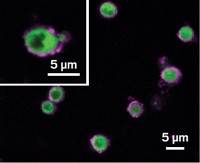Advertisement
Grab your lab coat. Let's get started
Welcome!
Welcome!
Create an account below to get 6 C&EN articles per month, receive newsletters and more - all free.
It seems this is your first time logging in online. Please enter the following information to continue.
As an ACS member you automatically get access to this site. All we need is few more details to create your reading experience.
Not you? Sign in with a different account.
Not you? Sign in with a different account.
ERROR 1
ERROR 1
ERROR 2
ERROR 2
ERROR 2
ERROR 2
ERROR 2
Password and Confirm password must match.
If you have an ACS member number, please enter it here so we can link this account to your membership. (optional)
ERROR 2
ACS values your privacy. By submitting your information, you are gaining access to C&EN and subscribing to our weekly newsletter. We use the information you provide to make your reading experience better, and we will never sell your data to third party members.
Materials
Tiny Backpacks For Cells
Polymer patches add cargo to cells without disturbing normal activities
by Carmen Drahl
November 17, 2008
| A version of this story appeared in
Volume 86, Issue 46

CELLS CAN NOW accessorize with the latest in multilayered polymer patches without fear of cramping their style. The patches attach to immune cell surfaces like backpacks on schoolchildren, and they don't interfere with regular cell functions (Nano Lett., DOI: 10.1021/nl802404h). The nanobackpacks could one day turn cells into drug delivery vehicles.
Several teams have tried to give cells new functions, including drug delivery, by encasing them in polymer shells that can be derivatized. But polymer encasement isn't universally applicable because "many cells need to interact with their surroundings to do their jobs," says MIT materials scientist Michael F. Rubner. Rubner teamed up with MIT engineers Darrell J. Irvine and Robert E. Cohen to figure out how to functionalize immune cells, which need their surfaces to communicate properly.
They settled on three-layer polymer patches that cover only part of cells' surfaces. MIT graduate student Albert J. Swiston built the patches, which contain a customizable cargo layer sandwiched between a hyaluronic acid-based layer for attachment to immune cells and a layer that tethers the patch to a glass surface. After assembly, he delivered cells to the patches with a pipette. A temperature change dissolved the tethering layer, leaving free-floating cells with exposed cargo. The team demonstrated the approach by using patches loaded with magnetic nanoparticles to control the movement of mouse immune cells by applying a magnetic field.
The study is "a step toward exploiting the power and potential of layer-by-layer assembly in biomedical applications," says Mike McShane, an expert in materials patterning at Texas A&M University.
"Living cells don't particularly like to have external, synthetic entities attached to them," says Raz Jelinek, a membrane biophysicist at Ben-Gurion University of the Negev, in Israel. The MIT team's elegant work circumvents that problem, but they still must determine whether the patches elicit immune reactions, he says.
The work is at an early stage and animal testing has yet to take place, Rubner says. But because the cargo-laden polymer patches are made before any cells enter the picture, polymerization and derivatization chemistries do not affect cells directly and therefore can quickly be adapted, he adds.



Join the conversation
Contact the reporter
Submit a Letter to the Editor for publication
Engage with us on Twitter